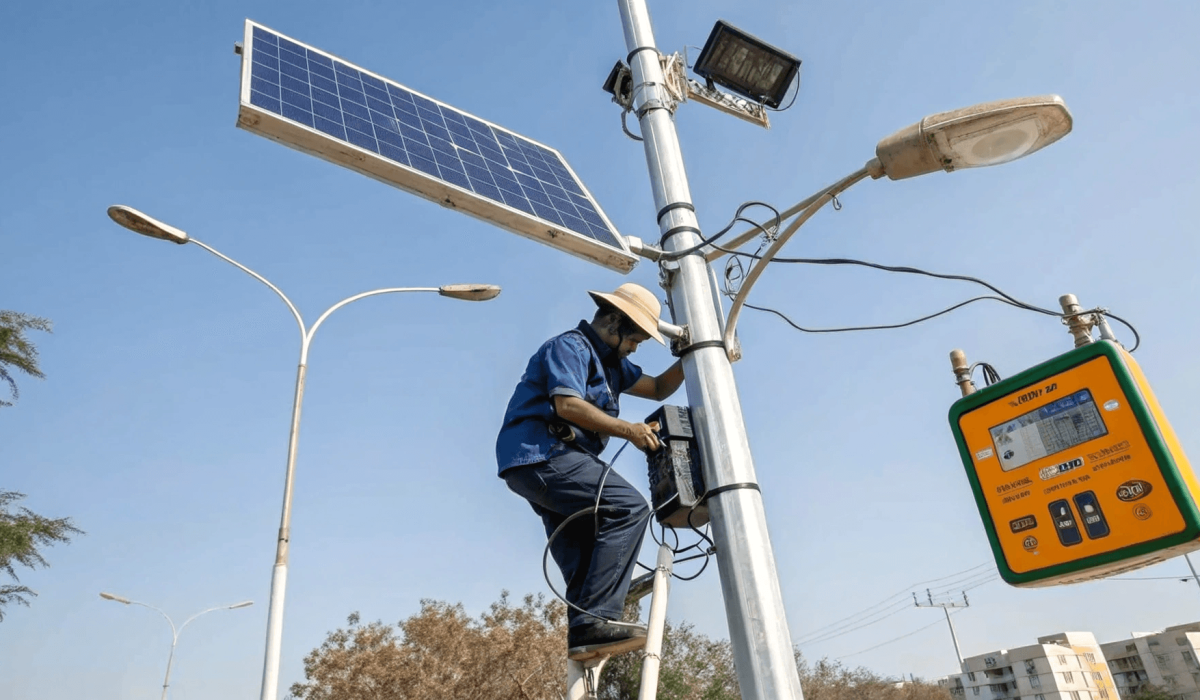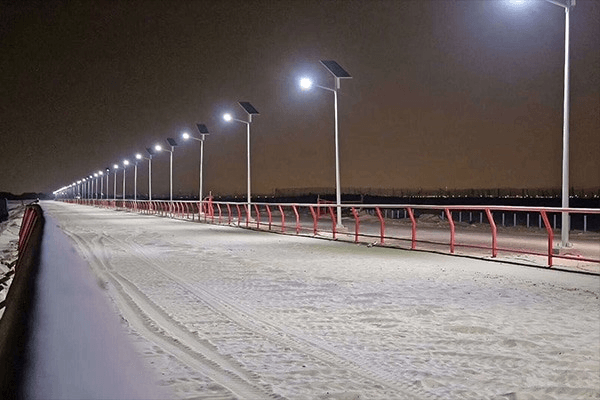Solar street lights provide eco-friendly and sustainable illumination, but over time, they can face operational challenges. Without proper maintenance, performance declines, leading to higher costs and unreliable lighting.
Regular maintenance ensures solar street lights operate efficiently, extending their lifespan and reducing unexpected failures. Addressing common issues like battery degradation[^1], LED failures[^2], and wiring problems prevents costly repairs.
By implementing routine maintenance, solar street lights can function optimally for years, reducing environmental impact and ensuring cost savings.
Ensuring Optimal Performance Through Maintenance
Over time, solar street lights can suffer from energy losses, dimming lights, and electrical failures. Addressing these problems early can prevent complete system breakdowns.
Maintenance plays a crucial role in ensuring optimal lighting performance, improving energy efficiency, and preventing premature failures.
2.1 Addressing Battery Degradation
Batteries store energy for nighttime lighting, but they lose efficiency over time.
- Signs of degradation – Dimming lights, reduced backup time, and frequent power failures.
- Regular maintenance steps:
- Check battery voltage and charge retention every 3-6 months.
- Replace old batteries before complete failure to prevent outages.
- Use high-quality lithium-ion batteries for longer lifespan and better efficiency.
2.2 Maintaining Solar Panel Efficiency
Solar panels collect sunlight, but dirt, debris, and harsh weather conditions reduce their energy absorption.
- Maintenance steps:
- Clean panels every 3 months with mild soapy water.
- Avoid abrasive chemicals that damage the panel surface.
- Remove obstructions like leaves, dust, and bird droppings regularly.
2.3 Preventing LED Failures
LEDs provide bright, energy-efficient lighting, but overheating and poor-quality components can lead to early failures.
- Common causes of LED failures[^2] – Poor heat dissipation, power surges, and substandard LED chips.
- Maintenance steps:
- Use high-quality LED chips with proper heat dissipation.
- Inspect for overheating and adjust the heat sink if needed.
- Replace faulty LEDs early to maintain brightness levels.
2.4 Protecting Against Water Damage
Moisture exposure can corrode electrical components, leading to short circuits.
- Maintenance steps:
- Seal all electrical connections properly to prevent water leaks.
- Inspect waterproofing materials every 6 months for wear and tear.
- Repair damaged seals and replace corroded parts immediately.
2.5 Resolving Controller and Wiring Issues
Loose connections and wiring failures disrupt lighting performance.
- Maintenance steps:
- Inspect and tighten all electrical connections every 6 months.
- Replace damaged or corroded wiring to maintain power flow.
- Update controller firmware for improved energy efficiency.
2.6 Correcting Installation Mistakes
Improper installation can cause misaligned solar panels, unstable poles, and inefficient energy use.
- Maintenance steps:
- Ensure poles are securely anchored to prevent tilting.
- Adjust solar panels for maximum sunlight exposure.
- Check mounting structures for loose bolts and fix them as needed.
Proactive Maintenance Practices for Solar Street Lights
Instead of waiting for issues to appear, proactive maintenance prevents failures and ensures smooth operation.
Routine inspections, cleaning, and regular component checks keep solar street lights functioning at peak performance.
3.1 Regular Inspections and Preventive Checks
Regular inspections identify wear and tear before major failures occur.
- Maintenance steps:
- Conduct visual checks every 3-6 months to spot corrosion or damage.
- Schedule professional maintenance annually to assess system health.
3.2 Cleaning and Maintaining Solar Panels
Dust and dirt significantly reduce solar panel efficiency[^3].
- Cleaning guidelines:
- Use a soft brush or cloth with mild detergent to clean surfaces.
- Avoid abrasive materials that may scratch the panel and reduce efficiency.
3.3 Regular Battery Monitoring
Ensuring batteries maintain optimal charge cycles prevents sudden failures.
- Steps for effective battery maintenance:
- Test battery voltage monthly to track energy storage capacity.
- Replace batteries before they completely lose efficiency.
3.4 Securing Electrical Connections
Loose connections cause flickering lights or sudden shutdowns.
- Maintenance steps:
- Inspect and tighten all wire joints every 6 months.
- Use corrosion-resistant connectors for long-term durability.
3.5 Keeping Controllers Updated
Outdated controllers waste energy and reduce lighting efficiency.
- Maintenance steps:
- Update firmware to improve energy management.
- Upgrade controllers when new technology enhances performance.
Long-Term Advantages of Regular Maintenance
Regular maintenance reduces long-term costs, improves efficiency, and extends the lifespan of solar street lights.
A well-maintained system is more reliable, cost-effective, and environmentally friendly.
4.1 Cost Savings
Preventive maintenance reduces expensive repairs and frequent replacements.
- Minimizes sudden failures, lowering repair costs.
- Extends component lifespan, reducing replacement expenses.
4.2 Increased Efficiency
Well-maintained lights provide consistent brightness and energy efficiency.
- Optimized solar panels ensure maximum power absorption.
- Healthy batteries store energy efficiently for nighttime use.
4.3 Extended Lifespan
A properly maintained system lasts significantly longer.
- Reduces need for frequent replacements, lowering long-term costs.
- Prevents early degradation of key components like batteries and LEDs.
4.4 Reliability and Safety
Reliable solar street lights improve public safety.
- Prevents sudden outages, ensuring continuous illumination.
- Reduces electrical hazards, preventing short circuits and shocks.
Why Choosing High-Quality Solar Street Lights from China Is More Cost-Effective
Importing high-quality solar street lights from China provides superior durability, better materials, and lower costs.
China’s advanced manufacturing capabilities ensure high-performance lighting solutions at competitive prices.
Advantages of Buying from China
| Feature | Locally Available Lights | Imported from China |
|---|---|---|
| Cost per Unit | Higher | Lower (bulk discounts available) |
| Quality | Varies | High-efficiency models |
| Battery Life | 2-3 years | 5+ years (Lithium-ion) |
| Customization | Limited | Full customization |
| Manufacturing Efficiency | Moderate | Advanced technology and strict quality control |
Key Benefits
- Lower Manufacturing Costs – Large-scale production reduces unit costs.
- Better Quality Materials – High-quality LEDs, long-lasting batteries, and durable poles.
- Customization Options – Tailor-made solutions for specific needs.
- Reliable Supply Chain – Fast production and shipping ensure timely deliveries.
Conclusion
Regular maintenance is essential for maximizing the performance and lifespan of solar street lights. A well-maintained system saves costs, ensures reliability, and improves sustainability.
Investing in high-quality solar street lights from China provides cost-effective, durable, and efficient lighting solutions. A proactive maintenance approach prevents expensive repairs and enhances long-term efficiency.
[^1]: Understanding battery degradation is crucial for maintaining solar street lights effectively and ensuring their longevity.
[^2]: Preventing LED failures is essential for maintaining brightness and energy efficiency in solar street lighting systems.
[^3]: Improving solar panel efficiency directly impacts energy absorption and overall performance of solar street lights.





